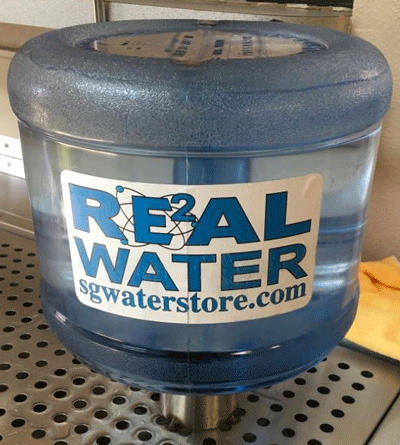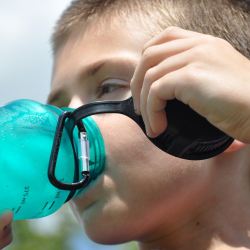In addition to bottled hope, the $168 billion dietary supplement industry furnishes surplus amino acids, vitamins, minerals and enzymes to those who aren’t extracting the necessary requirements from regular food, drink, and life experiences. Now, we can add negative ions to the list, thanks to ionized, or alkalized, water.
While the FDA does regulate both finished dietary supplements and dietary ingredients, dietary supplements are regulated under the Dietary Supplement Health and Education Act of 1994 (DSHEA):
“Manufacturers and distributors of dietary supplements are prohibited from marketing products that are adulterated or misbranded. That means that these firms are responsible for evaluating the safety and labeling of their products before marketing to ensure that they meet all the requirements of FDA regulations.”
Hope-peddling and endorsing health benefits however, need not be affixed to the product label to be pervasive and entrenched. Magazines, websites, social media all tout their benefits - ranging from combatting obesity, ramping up the immune system, promoting a sense of overall health and well-being, slowing aging, offering protection from nuclear fallout, and giving the body more energy. Proselytizing the benefits of these products is not limited to health literature. Financial sites promoting investment opportunities also help the cause:
“Dietary supplements can also replace prescription medications, as well as help reduce severe wear and tear particularly for the elderly.” Globe and Mail
Bottled Water
Not one to miss a good opportunity, the supplements industry has now focused on upping the alkaline levels of good old plain neutral water. But the FDA also has fairly hefty inspection and manufacturing requirements under its Current Good Manufacturing Practices (CGMPs) for bottled water, as well, requiring producers to:
- Process, bottle, hold, and transport bottled water under sanitary conditions.
- Protect water sources from bacteria, chemicals, and other contaminants.
- Use quality control processes to ensure the bacteriological and chemical safety of the water.
- Sample and test both source water and the final product for contaminants.
Yet dangers still abound. And there are pockets of the industry that seem to swim under the radar screen. Detection – and publication of dangers- is often evaded or delayed. In this instance, we have trial lawyers to thank for bringing the latest “scandal” to light.
REAL WATER
 Last November, the Southern Nevada Health Department began receiving reports that eleven children had suffered acute non-viral hepatitis. The common thread of all cases was drinking REAL WATER, marketed as striving to be “the healthiest drinking water available today.” It took till March before the FDA was notified, right about when a lawsuit was filed on behalf of the Wren family against AffinityLifestyles, REAL WATER’s manufacturer.
Last November, the Southern Nevada Health Department began receiving reports that eleven children had suffered acute non-viral hepatitis. The common thread of all cases was drinking REAL WATER, marketed as striving to be “the healthiest drinking water available today.” It took till March before the FDA was notified, right about when a lawsuit was filed on behalf of the Wren family against AffinityLifestyles, REAL WATER’s manufacturer.
What makes REAL WATER so special? It’s water, after all. Well, it has added negative ions, making it slightly alkaline (or basic, like baking soda) and ostensibly “healthier.” Typically, water has a neutral pH, meaning it is neither acidic nor basic. [1] Real Water says its product "promotes a balanced pH" and can "detoxify," but notes that "these statements have not been evaluated" by the FDA.
Nevada residents Christopher Wren, his wife, and son began drinking the stuff – that is until they became so sick, back in August, that their livers failed. In the case of Mr.Wren and his son, the damage was so severe that they became eligible for liver transplants. Five additional children suffered severe cases – although eventually recovered. But while the local department of health investigated, it appears that not until the filing of the Wren lawsuit was the FDA advised. They promptly disseminated warning and recall notices on March 16, seven months after local health authorities first detected the problem.
The FDA notification, however, is notoriously incomplete. On April 1, the CDC disseminated an official health advisoryadvising against using the water in any form, mentioning, but trivializing, the adult cases. While the manufacturer is cooperating with the FDA and removed the product from distribution, it may still be possible to secure it online.
The current belief is that the water somehow became contaminated with an extrinsic toxic substance, although there is no hard evidence pointing in that direction. Notwithstanding the common denominator of drinking REAL WATER in all who sickened, proving Wren’s case against REAL WATER’s manufacturer might be difficult. According to the CDC, non-viral hepatitis can also be caused by other exposures, which the lawyers will have to exclude. These include:
- Medications
- Contaminated food
- Dietary and herbal supplements
- Traditional or home remedies
- Wild-growing mushrooms and plants
- Chemicals such as metals, solvents, paint thinners, or pesticides
Could another dietary supplement be the most likely culprit? Recent reports indicate that herbal and dietary supplements (HDS) account for 16% of liver damage in the US, and products containing green tea extracts were also noted as contributory. Given that the majority of those affected were children, the causal likelihood of some of these exposures, such as anabolic steroids, another contributor to liver failure, seems minimal, leaving the likely culprits damage caused by alkaline water itself, or in synergistic or additive combination with other exposures, such as some medications.
Are there health concerns regarding alkaline water that we don’t know about? We shall have to await further research and hopefully the FDA is on it. Interestingly, like the effect of acidity leaching lead from pipes, mildly alkalinized water can leach copper in pipes, which also can be hazardous.
Probably the deepest concern is that it took so long for the FDA to discover the problem, issue the recall, and begin its investigation. It seems we need to thank the trial lawyers for bringing the matter to our collective attention. Gulp.
[1] pH is a scale of acid and bases. Humans are slightly basic, with a pH of roughly 7.40. Lower numbers are more acidic, higher numbers more basic. Like battery acid or stomach acid, or ammonia, the extremes of the scale are highly corrosive. The mucous lining of the stomach protects that organ from corrosion, but if stomach acid regurgitates upward in the unprotected esophagus, it can cause acid reflux. Natural mildly acidic products, like cranberry juice or Greek yogurt, have been touted for medicinal properties. Drinking acidic water is considered dangerous because it can dissolve metals in pipes, like the lead responsible for the events in Michigan last year.

